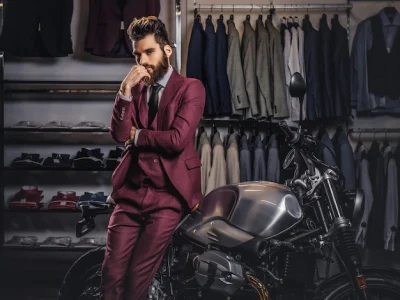
The marriage of athletic functionality and fashion sensibility has irreversibly transformed the way we dress for comfort and style.
From the jogging booms of the ’70s to today’s high-fashion interpretations, activewear has become a staple in both our wardrobes and cultural lexicon.
Athleisure wear, a term coined to represent this hybrid fashion, blurs the lines between what’s worn for workouts and what’s worn in casual, everyday life. Below, we will explore the fascinating trajectory of activewear and its deep impact on the fashion industry and modern lifestyle.
The Emergence of Activewear in Fashion History

The genesis of activewear in fashion traces back decades when it served primarily functional roles in specific sports. The 1970s and 1980s witnessed a surge in recreational jogging, prompting the creation of fashion that combined comfort with style for athletic purposes. Brands recognized the potential of this fusion, offering fashionable sportswear.
By the 1990s and early 2000s, activewear transcended gym boundaries, influenced by celebrity workout videos. Appearing in various fabrics and colors, it became a trend emphasizing both aesthetics and functionality, expanding beyond traditional athletic settings.
As the 21st century progressed, major fashion houses integrated activewear into their collections, evident in high-end and streetwear collaborations. This fusion of practicality and high fashion confirmed activewear’s place on runways and streets alike.
With the rise in active lifestyles and demand for versatile clothing, activewear has become a significant segment of the fashion industry. Balancing performance and fashion has broadened the consumer base, signifying a cultural shift in fashion rather than a passing trend.
Athleisure as a Cultural Phenomenon Changing Lifestyle Norms
The term ‘athleisure’ embodies the modern embrace of comfort and functionality in everyday clothing. It reflects society’s emphasis on fitness, well-being, and an active lifestyle. Athleisure’s versatility caters to both active pursuits and leisure, establishing itself as a lifestyle rather than a passing trend.
This trend has disrupted traditional workplace attire, with comfortable yet stylish sneakers and joggers finding acceptance in professional settings. The appeal of athleisure extends beyond fashion, aligning with the demands of modern urban living where clothing must seamlessly transition between various activities.
Celebrities, influencers, and tastemakers champion athleisure, propelling its popularity through social media. From music festivals to urban streets, athleisure has become synonymous with contemporary style, appealing to diverse demographics.
The Impact of Technology and Innovation on Activewear Design
Advancements in textile technology have revolutionized activewear, enhancing both performance and comfort. Moisture-wicking fabrics, temperature-regulating materials, and stretch technology have improved sportswear functionality, appealing to a broader audience beyond just athletes.
The integration of wearable technology further blurs the lines between fashion and tech in activewear. Smart fabrics capable of monitoring health metrics and connecting with mobile devices add utility and sophistication to these garments.
Manufacturers are not only embedding technology but also employing innovative design techniques to enhance both aesthetics and functionality. Laser-cut patterns for breathability and seamless construction to minimize discomfort are just a few examples.
Technological strides meet consumer demand for personalized fashion. Custom-fit clothes, 3D-printed footwear, and adaptive designs cater to diverse body types, emphasizing comfort, style, and personalization in activewear.
Sustainability and Ethical Considerations in Modern Activewear

The activewear sector, mirroring broader trends in fashion, is under pressure to prioritize sustainability and ethical responsibility. As outdoor activities are closely linked to environmental concerns, consumers are seeking brands that share their values. This has led to a surge in demand for eco-friendly materials, ethical manufacturing, and transparent supply chains.
Brands are responding by innovating with recycled materials and reducing waste. Some are even creating entire lines from ocean plastics or sustainable fibers, appealing to eco-conscious consumers. Additionally, there’s a push towards circular fashion, encouraging reuse and recycling.
The focus is shifting towards the ethical stance of brands, with transparency and sustainability becoming crucial factors in consumer decisions. This shift is steering the activewear industry towards a more accountable and sustainable future.
Activewear Brands Leading the Athleisure Movement and What Sets Them Apart
In the competitive athleisure market, leading brands distinguish themselves through a fusion of innovation, design, and brand identity that resonates with consumers. Nike, Adidas, and Under Armour excel not only in performance activewear but also in creating stylish and functional athleisure pieces.
Lululemon and Hyba focus on fit, quality, and promoting an active lifestyle, fostering strong customer loyalty through specialized stores and community events.
Luxury brands have also embraced athleisure, incorporating high-end materials and avant-garde designs into their collections, thus creating a premium niche within the market.
Altogether, the athleisure trend has become more than a passing fashion phase, demonstrating a lasting impact on consumer preferences and lifestyles. Its enduring popularity and expansion highlight a significant shift in values, emphasizing a blend of practicality, fashion, sustainability, and technology.
As top brands maintain rigorous standards, athleisure is reshaping not only clothing choices but also the broader fashion landscape, promising ongoing evolution and excitement.
Read Also:















